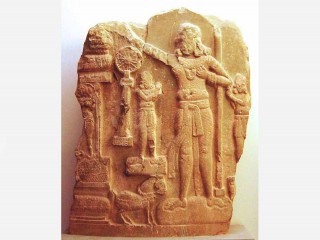
Ashoka biography
Date of birth : -
Date of death : -
Birthplace : Magadha Bihar, India
Nationality : Hindi
Category : Historian personalities
Last modified : 2010-06-21
Credited as : Indian emperor, ,
75 votes so far
His greatest achievements were spreading Buddhism throughout his empire and beyond. He set up an ideal government for his people and conquered many lands, expanding his kingdom. The knowledge of Ashoka’s early reign is limited because little information was found. His edicts and inscriptions allowed us to understand his reign and empire, and have an insight into the events that took place during this remarkableperiod of history. Eight years after he took his throne, Ashoka’s powerful armies attacked and conquered Kalinga (present day Orissa). Although he had conquered many other places, this violent war was thelast war he ever fought and a turning point of his career. He was disgusted by the extreme deaths of numerous civilians, especially the Brahmans.
All these misfortunes brought Ashoka to turn into a religious ruler compared to a military ruler. As he turned to Buddhism, he emphasized dharma (law of piety) and ahimsa (nonviolence). He realized he could not spread Buddhism all by himself and therefore appointed officers to help promote the teachings. These officers were called Dhamma Mahamattas or “Officers of Righteousness”" They were in charge of providing welfare and happiness among the servants and masters. Preventing wrongful doings and ensuring special consideration was also their duty.
Emphasizing his role as king, he paid close attention to welfare, the building of roads and rest houses, planting medicinal trees, and setting up healing centers. In order to pursue ahimsa, Ashoka gave up his favorite hobby of hunting and forbade the killing of animals, spreading vegetarianism throughout India. Furthermore, his soldiers were taught the golden rule- to behave to others the way you want them to behave to you, which is the basic law of life. In the nineteenth century, a large number of edicts written in Brahmi script carved on rocks and stone pillars were discovered in India, proving the existence of Ashoka.
These edicts, found scattered in more than 30 places throughout India, Nepal, Pakistan and Afghanistan, are mainly concerned with moral principles Ashoka recommended, his conversion to Buddhism, his personality and his success as a king. The Minor Edicts is a summary of Ashoka’s instruction of dharma, which talks about the purity of thoughts, kindness, thruthfulness, reverence, and other good morals of life. The Fourteen Rock Edicts were the major edicts, and issued the principles of the government. Some of these edicts tell of animal sacrifices, the principles of dharma, the Kalinga War, and religious toleration. There is also record of Ashoka’s famous statement of “All men are my children”. The Seven Pillar Edicts deals with some achievements of amudragupta. Ashoka died in the thirty-eighth year of his reign, 232 B.C. The Buddhist ideas no longer inspire the government and at the same time, his descendents quarrel over the successions. In addition, the army, having become less warlike, was no longer able to defend the empire from invasion. In less than fifty years after his death, the Maurya Empire collapsed and fell into pieces.
















